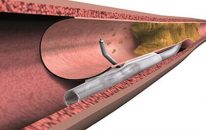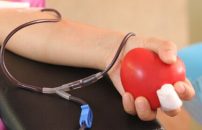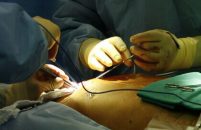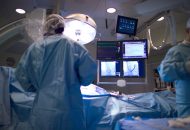For the first time, the American College of Cardiology (ACC) has carried out a survey on this phenomenon, and more than 25% of Cardiologists have reported the characteristic symptoms of burnout. This syndrome is known, among other things, for chronic fatigue at work, low self-esteem and difficulty to focus, associated with stress and aggressiveness. These findings should be taken…
Aspirin During Noncardiac Surgery: Only in Patients with Prior Angioplasty
A new analysis from the POISE-2 study suggests that aspirin should not be withheld prior to noncardiac surgery in patients with a history of coronary angioplasty, even if their coronary procedure occurred several years earlier. Patients with a history of coronary angioplasty who need cardiac surgery are more likely to benefit from continued aspirin therapy,…
iFR in Nonculprit Lesions: Measurement Timing May Change History
During primary angioplasty, it is not uncommon to see several other lesions in coronary arteries. Current guidelines advise against the treatment of these lesions in the same primary angioplasty procedure, although there is evidence supporting such a course of action that may warrant changes in these recommendations. The functional assessment of these nonculprit lesions may…
Clopidogrel or Ticagrelor in Patients with Acute Coronary Syndrome Treated with New-Generation DES: CHANGE DAPT
Courtesy of Dr. Pablo Baglioni. This is a prospective observational study with a 1-year follow-up analyzing 2062 patients with acute coronary syndrome (ACS) who have been treated with coronary angioplasty using new-generation drug-eluting stents (DES). Patients were included between December 21, 2012 and August 25, 2015. On May, 2014, due to changes in international guidelines, clopidogrel…
6 articles on Total Chronic Occlusions that you can not stop reading
1) Radiation Exposure in Chronic Total Occlusions Even in the hands of experienced operators, rechanneling and angioplasty of a chronic total occlusion (CTO) results in patients and the whole cath lab team receiving high doses of radiation, according to this registry presented at the American Heart Association 2017 Scientific Sessions. Read more 2) Should We Begin to Use IVUS in CTO?…
Arterial Access After Thrombolysis
In the subgroup of patients with ST-segment elevation myocardial infarction who fail thrombolysis, transradial access reduces both bleeding and mortality, according to the results of this new study recently published in JACC Cardiovascular Interventions. Overall, transradial access following failed thrombolysis was associated with a 70% reduction in vascular complications, a 28% reduction in combined in-hospital…
Patients and Healthcare Providers Benefit from Less Symptoms and Lower Costs with FFR
Previous studies in which revascularization was guided by angiography alone found that coronary angioplasty does not improve outcomes compared with optimal medical treatment in patients with chronic stable angina. The FAME 2 trial (Fractional Flow Reserve Versus Angiography for Multivessel Evaluation) compared angioplasty guided by fractional flow reserve (FFR) with optimal medical treatment, arriving to…
Non-Invasive FFR: CT Evolves from Anatomical to Functional
In the US, more than 4 million patients with chronic stable angina are looking to rule out heart disease. Most undergo functional diagnostic studies that might lead to invasive coronary angiography followed by revascularization. CT has become an alternative diagnostic tool thanks to its precision to rule out heart disease (negative predictive value between 97…
Radiation Exposure in Chronic Total Occlusions
Even in the hands of experienced operators, rechanneling and angioplasty of a chronic total occlusion (CTO) results in patients and the whole cath lab team receiving high doses of radiation, according to this registry presented at the American Heart Association 2017 Scientific Sessions. Up to 23% of patients who undergo rechanneling of a CTO receive…
Bilateral Mammary Artery Graft to Reduce the Chance of Repeat Revascularization
According to previous studies, patients receiving bilateral internal mammary artery conduits during coronary artery bypass grafting have better survival than those receiving a single internal mammary artery. The reason behind this remains unclear, let alone whether there really is lower repeat revascularization rate. This analysis compared timing, frequency, and type of repeat coronary revascularization among patients…
Protective Shield RADPAD Reduces the Radiation Dose Received by Operators in the Cath Lab
Despite technological developments, all people working at a cath lab are inevitably exposed to radiation and its effects. The radiation dose received by the operator is highly variable depending on procedure type, experience level, equipment used, patient characteristics, etc. Exposure to this scatter radiation may have deterministic effects, such as the onset of cataracts or…










